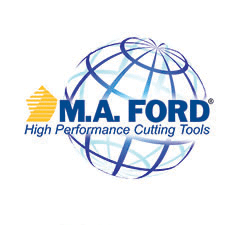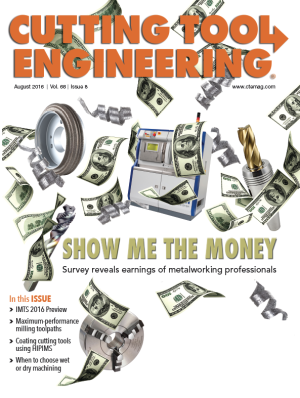Within the last decade, multiple endmilling developments have occurred. These include bold, new cutter designs, extremely tough but wear-resistant carbide grades and toolpaths that reduce mechanical shock to machine tool and cutter alike while reducing cycle times by 50 percent or more and extending tool life.
This new paradigm of metal removal makes it possible to successfully machine difficult-to-cut materials such as titanium and Inconel using even light-duty machine tools. Moreover, it can be done by anyone with a solid grasp of a few basic machining principles and a CAM system that generates the necessary toolpaths.

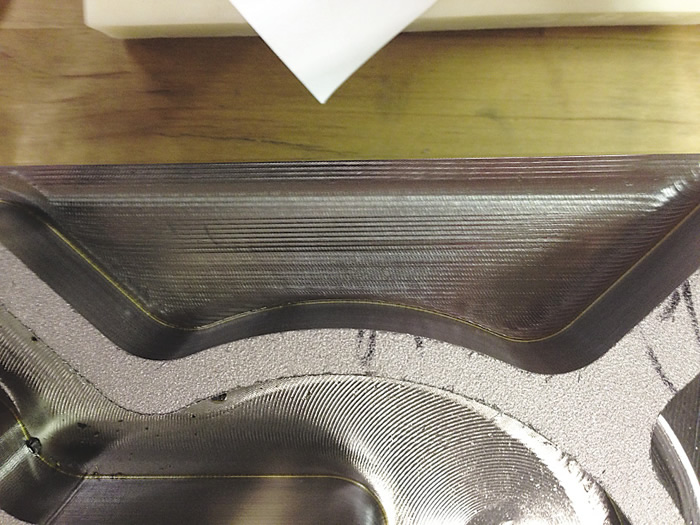
Straight-line peel milling on the edge of a workpiece. All Images courtesy M.A. Ford Manufacturing.

Old School
Before maximum-performance milling (MPM), shops took a more-traditional milling approach. This was not necessarily climb milling or conventional milling—although both play a factor in any milling operation—but rather the type of milling where a cutter is applied at low to moderate feeds and speeds to take heavy cuts, typically engaging 80 percent or more of the tool width and up to 1 diameter deep axially.
This approach can remove a large amount of material per pass, but it often causes minute chipping of the cutting edges, leading to unpredictable results and premature tool failure. The large amount of heat produced by such hogging cuts requires special tool coatings. Endmills require radial rake angles and core thicknesses specifically designed for this type of machining. Specifically, truncated, profile-style roughers, or corncob cutters, are needed to segment chips and reduce deflection during heavy cutting.
On manual equipment, such as manual knee or horizontal mills, this style of old-school milling was performed conventionally, meaning the cutter rotates opposite the direction of feed. This causes rubbing, deflection and heat. With the advent of NC machining centers and their enhanced rigidity, climb milling became possible. As a rule, “climbing” into a workpiece improves tool life and surface finish, but can cause chatter, which generally happens when taking a radial cut that equals 60 to 90 percent of the cutter diameter. This causes the rake face to slap the material rather than curling and severing it, and this technique is hard on the cutter and machine tool.

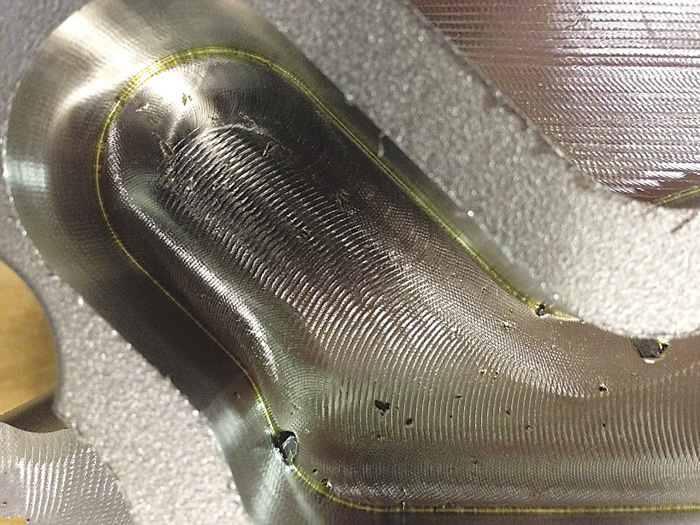
Trochoidal toolpaths are suitable in tight areas, such as slots and small pockets.

Machine builders responded by offering rigid machines with ample horsepower and torque, and duty cycles able to take long, continuous cuts under heavy loads. Machine spindles were likewise improved to endure the constant stresses involved.
Toolholders that eliminate tool pullout caused by high cutting forces were also required, but because machines of that vintage were anything but “high speed,” toolholder runout was not the concern it is today.
Peeling Out
Aerospace suppliers were perhaps the first to recognize the need for more-efficient machining processes. By optimizing stock removal and reducing the amount of power required to machine airfoils and other large surfaces, they realized significant energy savings. That optimization came in the form of radically new toolpaths, ones that remove relatively small amounts of material per pass but at much higher feed rates, while maintaining consistent cutter loads to prevent chatter and tool damage.
One of these is straight-line peel milling. It is defined as any toolpath that has a small radial DOC and large axial DOC that travels in a straight line along the inner or outer part of the workpiece. As with all types of peel milling, substantial increases in the feed rate and cutting speed are possible because of chip thinning, the formation of thick-to-thin chips that occurs while climb milling and taking light radial cuts. This reduces heat generation and cutting forces.

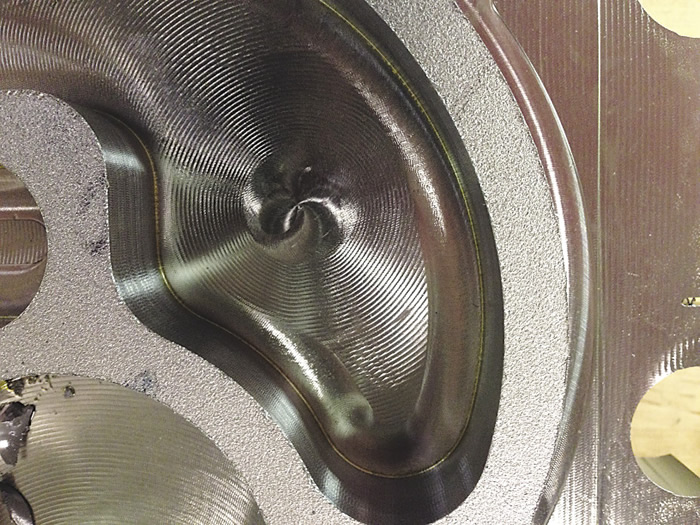
The center of this pocket shows where helical ramping stops and curvilinear spiral peel milling takes over. As the cutter moves into the narrow passage, trochoidal milling begins.

Another is trochoidal peel milling, a type of circular milling that includes simultaneous forward movements. The cutter follows a spiral toolpath to repeatedly remove “slices” of material. Trochoidal, a 2D toolpath, is also used in slot and pocket milling, where space for chip evacuation is limited. In addition, trochoidal peel milling is suitable for cleaning internal part corners, “picking” away at the material left by large roughing cutters.
Curvilinear spiral peel milling, also known as a morphing spiral, is yet another. It is a 2D spiraling cutter path often used in pocket milling. The step-overs are equal as the tool spirals out to complete a part feature. This reduces wasteful acceleration and deceleration by minimizing sharp corners.
For all peel milling methods, endmills with higher-density cutting edges can be applied to increase feed rates and subsequent metal-removal rates.
Mix and Match
Another type of MPM is pocket milling, which requires a starter hole. This hole can be generated with a drill but is more often achieved via a helical ramping routine performed with a center-cutting endmill. Helical ramping is the process of rotating a cutter in a circle up to two times its diameter while simultaneously feeding down in the Z-axis until reaching full axial depth. The circular rotation can be in either direction—clockwise or counterclockwise—which, in turn, enables climb or conventional milling.
All of these MPM methods might be used in a single part program, depending largely on part geometry, chip clearance and what the CAM system determines is most appropriate for the situation.

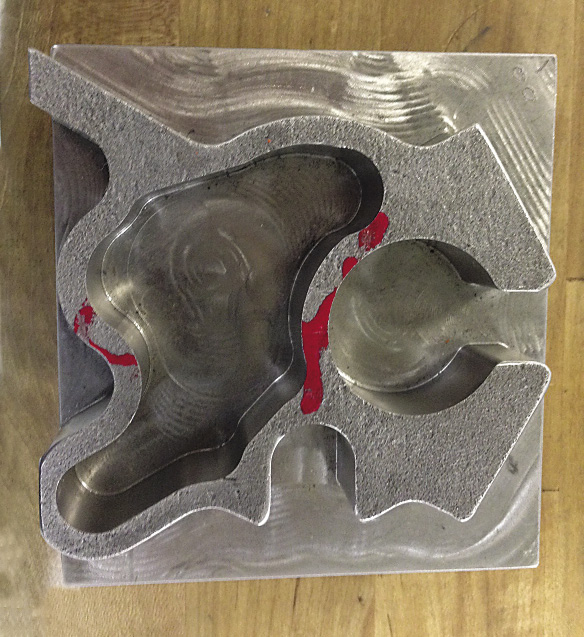
This test part uses all of the toolpaths mentioned in the article.

Large-core endmills are appropriate for peel milling, enhancing rigidity and enabling high feed rates. Tool engagement angles and DOC are kept as consistent as possible, and burying cutters in corners is strictly avoided. The resulting toolpath prevents chatter and tool breakage, imparts finer surface finishes, and produces straighter walls and more predictable machining.
Not So Fast
MPM is effective for a multiple materials and applications, but that doesn’t mean certain steps aren’t required to make it work properly. As mentioned earlier, a good CAM system is a prerequisite. Cycle time reduction is, of course, a primary goal of any CAM system evaluation, but ease of use and reducing programming time are also important. Develop an appropriate test part and criteria, and be sure to check the fruits of your CAM labor by machining the part on your equipment.
Because MPM allows feed rates perhaps dozens of times faster than conventional milling methods, the logical question becomes: Can my machine hack it? Control and servo systems must be fast and accurate enough to avoid overshooting corners or slowing down because of data starvation, such that the feed rate becomes inadequate and tool rubbing occurs.
Depending on the material, spindle speeds of four to five times higher than conventional milling are possible with MPM. When running above 10,000 rpm or so, use well-balanced toolholders. And even though cutting forces are far lighter with MPM, tool pullout is still a concern. Because MPM rips away more material in less time, a shrink-fit, hydraulic chuck or a Safe-Lock-style holder is recommended—no Weldon-shank tools are invited to this party.
You will discover that even tired, old, commodity machines can be turned into metal-eating monsters with MPM. Once all the MPM elements are in place, get to work testing—and documenting—your processes.
Contact Details
Related Glossary Terms
- centers
centers
Cone-shaped pins that support a workpiece by one or two ends during machining. The centers fit into holes drilled in the workpiece ends. Centers that turn with the workpiece are called “live” centers; those that do not are called “dead” centers.
- chatter
chatter
Condition of vibration involving the machine, workpiece and cutting tool. Once this condition arises, it is often self-sustaining until the problem is corrected. Chatter can be identified when lines or grooves appear at regular intervals in the workpiece. These lines or grooves are caused by the teeth of the cutter as they vibrate in and out of the workpiece and their spacing depends on the frequency of vibration.
- chip clearance
chip clearance
In milling, the groove or space provided in the cutter body that allows chips to be formed by the inserts.
- chuck
chuck
Workholding device that affixes to a mill, lathe or drill-press spindle. It holds a tool or workpiece by one end, allowing it to be rotated. May also be fitted to the machine table to hold a workpiece. Two or more adjustable jaws actually hold the tool or part. May be actuated manually, pneumatically, hydraulically or electrically. See collet.
- clearance
clearance
Space provided behind a tool’s land or relief to prevent rubbing and subsequent premature deterioration of the tool. See land; relief.
- climb milling ( down milling)
climb milling ( down milling)
Rotation of a milling tool in the same direction as the feed at the point of contact. Chips are cut to maximum thickness at the initial engagement of the cutter’s teeth with the workpiece and decrease in thickness at the end of engagement. See conventional milling.
- computer-aided manufacturing ( CAM)
computer-aided manufacturing ( CAM)
Use of computers to control machining and manufacturing processes.
- conventional milling ( up milling)
conventional milling ( up milling)
Cutter rotation is opposite that of the feed at the point of contact. Chips are cut at minimal thickness at the initial engagement of the cutter’s teeth with the workpiece and increase to a maximum thickness at the end of engagement. See climb milling.
- cutting speed
cutting speed
Tangential velocity on the surface of the tool or workpiece at the cutting interface. The formula for cutting speed (sfm) is tool diameter 5 0.26 5 spindle speed (rpm). The formula for feed per tooth (fpt) is table feed (ipm)/number of flutes/spindle speed (rpm). The formula for spindle speed (rpm) is cutting speed (sfm) 5 3.82/tool diameter. The formula for table feed (ipm) is feed per tooth (ftp) 5 number of tool flutes 5 spindle speed (rpm).
- endmill
endmill
Milling cutter held by its shank that cuts on its periphery and, if so configured, on its free end. Takes a variety of shapes (single- and double-end, roughing, ballnose and cup-end) and sizes (stub, medium, long and extra-long). Also comes with differing numbers of flutes.
- endmilling
endmilling
Operation in which the cutter is mounted on the machine’s spindle rather than on an arbor. Commonly associated with facing operations on a milling machine.
- feed
feed
Rate of change of position of the tool as a whole, relative to the workpiece while cutting.
- gang cutting ( milling)
gang cutting ( milling)
Machining with several cutters mounted on a single arbor, generally for simultaneous cutting.
- milling
milling
Machining operation in which metal or other material is removed by applying power to a rotating cutter. In vertical milling, the cutting tool is mounted vertically on the spindle. In horizontal milling, the cutting tool is mounted horizontally, either directly on the spindle or on an arbor. Horizontal milling is further broken down into conventional milling, where the cutter rotates opposite the direction of feed, or “up” into the workpiece; and climb milling, where the cutter rotates in the direction of feed, or “down” into the workpiece. Milling operations include plane or surface milling, endmilling, facemilling, angle milling, form milling and profiling.
- numerical control ( NC)
numerical control ( NC)
Any controlled equipment that allows an operator to program its movement by entering a series of coded numbers and symbols. See CNC, computer numerical control; DNC, direct numerical control.
- radial rake
radial rake
Also known as the tool back rake, the angle between the tooth face and the radial plane through the tool point.
- rake
rake
Angle of inclination between the face of the cutting tool and the workpiece. If the face of the tool lies in a plane through the axis of the workpiece, the tool is said to have a neutral, or zero, rake. If the inclination of the tool face makes the cutting edge more acute than when the rake angle is zero, the rake is positive. If the inclination of the tool face makes the cutting edge less acute or more blunt than when the rake angle is zero, the rake is negative.
- toolholder
toolholder
Secures a cutting tool during a machining operation. Basic types include block, cartridge, chuck, collet, fixed, modular, quick-change and rotating.
- toolpath( cutter path)
toolpath( cutter path)
2-D or 3-D path generated by program code or a CAM system and followed by tool when machining a part.
- toolpath( cutter path)2
toolpath( cutter path)
2-D or 3-D path generated by program code or a CAM system and followed by tool when machining a part.
 Gary L. Schmidt, an application engineer at M.A. Ford Manufacturing Co. Inc., Davenport, Iowa, contributed to this report. For more information about the company’s cutting tools, call (800) 553-8024 or visit www.maford.com.
Gary L. Schmidt, an application engineer at M.A. Ford Manufacturing Co. Inc., Davenport, Iowa, contributed to this report. For more information about the company’s cutting tools, call (800) 553-8024 or visit www.maford.com.

